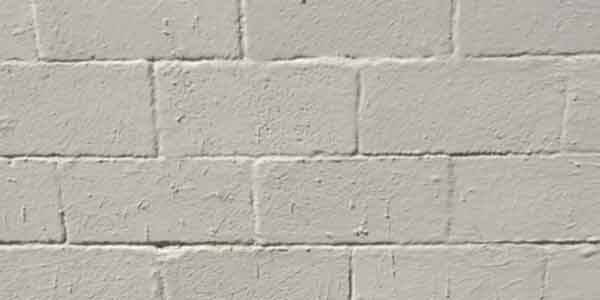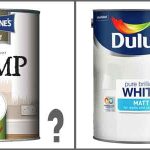The DIY Fix is reader supported. When you buy after clicking a link on our site, we may earn an affiliate commission.

Painting the exterior walls of your home can have several benefits. Firstly, it is a great way to freshen up its appearance. It even has the potential to add value to your home. But more importantly, painting an outside wall will offer a level of protection against the elements.
An important thing to remember, is painting an exterior wall will require a degree of planning and preparation. If you get this right, it will ensure good results and a wall that benefits from long-lasting protection.
But what do you do if the outside wall is damp? Can you paint a damp exterior wall? You should not paint a damp exterior wall until you have resolved any issues and allowed the wall to dry. You may also need to treat the wall to prepare it for painting. How you treat it will depend on the condition the wall is currently in.
In this article, we will set out the three steps you need to take before you can paint a damp exterior wall:
1) Establish what is causing the damp
2) Treat the cause of the damp
3) Drying and preparing the wall’s surface for painting.
Preparation is key when painting any wall
Giving the exterior walls of your property a ‘fresh lick of paint’, can be an inexpensive way to improve its appearance. It also provides an effective barrier from outside elements. Also, for many people painting an exterior wall can be a relatively easy DIY project. But, do not forget, preparation is important. You will need to properly prepare the surface before you paint, to get the best results.
This is especially true if you have damp on an outside wall. It is very important that you resolve this type of issue before you start to paint.
How to treat damp exterior walls before painting
To treat the problem correctly, you will need to understand what you are dealing with. In some cases, you may need the help of a professional, but often the cause is obvious.
Fixing the cause of the damp is essential before you paint your wall. If you don’t deal with the problem, it could return after the wall has been painted. You also need to allow the wall to dry out.
In most cases an exterior wall will just be wet from rain. But, if the wall has visible damp patches, or other issues such as water running on to it, this will need fixing. After you fix any issues, you must allow time for the wall to dry out thoroughly.
If your property is rendered, damage to the render can also be a serious issue. If neglected, it can cause serious problems – such as penetrating damp. Signs of trouble are cracks or bulges to the render. This can expose bare patches to damp. Fix and seal even small hairline cracks as soon as you notice them. Otherwise, water can penetrate and cause further damage.
Prepping exterior walls before painting
Once you have treated the cause of damp, you can move onto then next step. This is preparing the exterior wall before painting.
Firstly, you need to determine if ladders or scaffolding are needed? Assess the risk involved and also consider your own confidence level. If you do need scaffolding, you should hire a qualified builder or scaffolding contractor to erect and secure any scaffolding. You can find the rules for scaffolding here.
If the outside wall is old, it’s likely there is damage to the pointing. In this scenario, the old mortar will need removing and repointing. Any cracks or other problems should also be repaired.
You should always paint on a clean wall. Remove any moss or algae beforehand. A soft brush and a small hobby knife are perfect for the job. Once removed, treat the wall with water & bleach (50/50 diluted). Next, rinse the wall and allow to dry. This should not take long, but it will depend on the weather
Another option is to use a pressure washer on the wall. This is an effective way of removing dirt, debris, and loose paint from the surface. After use, you will need to leave the wall to completely dry out.
Dealing with plant roots and powdery deposits
If you find plant roots are visible behind render or in the pointing, scrape the roots off with a scraper. Scrub any signs of root fragments and tendrils from the surface using a nylon scrub brush. For anything that remains, prepare a mild detergent solution. Mix 1 gallon of water with 1 tablespoon of liquid detergent and apply to the surface. Rinse thoroughly afterwards.
Walls that have been painted previously, are often affected by powdery deposits. This means that you will need to fix the surface with a primer before applying a new coat of paint. If you skip this step, you run the risk that newly applied paint will become loose and start to flake off.
The best choice of paint for exterior walls is usually an acrylic masonry paint. This gives the surface waterproof protection. Not only that, it enables moisture in the wall to evaporate to the outside. You can read more about exterior paints here
Benefits of painting an exterior wall
The main benefit of painting an exterior wall, is it provides a layer of waterproof protection. This will stop water from getting into your home and causing internal damp problems. It effectively adds an extra waterproof barrier around your property.
The three common types of internal damp are condensation, penetrating damp and rising damp. Penetrating damp is the main issue that can be caused by external problems. Defects on an exterior wall can lead to issues inside. So, repairing and painting an exterior wall is a great way to guard against internal damp issues later.
Key takeaways: Painting a damp exterior wall
The key takeaway about painting a damp exterior wall, is to have patience. Having established what is causing the damp, you need to treat it correctly.
Finally, the wall needs to be dried out and prepared. These steps can be frustrating and time-consuming. However, if you want to enjoy the best results, it’s well worth the effort. With this type of job, 80% of the time will be spent on preparation. If you bear this in mind, you are more likely to achieve a high quality finished job.


